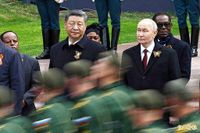On September 1, 2025, Russian President Vladimir Putin and Chinese President Xi Jinping were seen deep in conversation at the Shanghai Cooperation Organisation (SCO) Summit in Tianjin, a moment that, in hindsight, seems to symbolize the growing alignment between Moscow and Beijing. Just a few months earlier, on May 9, the two leaders attended a flower-laying ceremony at Moscow’s Tomb of the Unknown Soldier, underscoring the public warmth between the countries. But behind these ceremonial gestures, a far more consequential partnership has been quietly taking shape—one that could reshape the military balance in East Asia.
According to a trove of about 800 pages of leaked Russian documents, analyzed by the London-based Royal United Services Institute (RUSI) and corroborated by the British analytical center RUSI, Moscow has agreed to provide Beijing with a significant package of military equipment, technology, and training. These documents, obtained from the Black Moon hacktivist group and reviewed by outlets such as CNN and the Taipei Times, paint a picture of a deepening military alliance that could accelerate China’s airborne capabilities by as much as a decade or more.
The deal, which surfaced in 2023, includes the sale of 37 light amphibious assault vehicles, 11 amphibious anti-tank self-propelled guns, and 11 airborne armored personnel carriers, along with command and observation vehicles. The total cost? More than $210 million, according to RUSI’s analysis. But the hardware is only part of the story. Russia has also agreed to transfer technologies that would allow China to manufacture similar weapons domestically—a move that could have long-term implications for regional security.
What’s particularly striking is the integration of Chinese communications and command systems into the Russian-supplied vehicles. This hybrid approach, as described in the leaked materials, means Chinese paratroopers will be trained by Russian instructors in both Russia and China, covering everything from parachuting and combat command to complex maneuvering. The goal: to bring Chinese airborne forces up to a level of operational experience they have historically lacked.
As RUSI associate fellow Oleskandr Danylyuk put it, “The Chinese school of airborne landing is very young.” He added that Moscow’s assistance could help speed up China’s airborne program by about 10 to 15 years—a leap that would be hard to overstate in military terms. RUSI’s senior research fellow Jack Watling echoed this assessment, emphasizing that “the greatest value of the deal” for China is likely in the training and procedures for command and control of parachute forces, because Russia has “combat experience,” whereas China does not.
The documents reference a series of high-level meetings between Chinese and Russian delegations, including a notable session in Moscow on March 8, 2024. There, Russia reportedly agreed to provide China with technical details about the Dalnolyot parachute system, a sophisticated rig capable of dropping personnel and equipment from altitudes as high as 8 kilometers—and in temperatures as low as minus-60°C. The system would allow Chinese forces to glide up to 80 kilometers after parachuting, enabling special forces to infiltrate foreign territory without being detected. “Chinese special forces groups to penetrate the territory of other countries without being noticed,” the report said, highlighting the potential for covert operations in contested regions.
While the documents do not mention Taiwan by name, the implications are clear. Under President Xi Jinping, China has embarked on a sweeping modernization of its armed forces, aiming to transform the People’s Liberation Army (PLA) into a “world-class” military by 2050. High-ranking U.S. officials have suggested that Xi has ordered his military to be prepared for a possible invasion of Taiwan as early as 2027. The new Russian equipment and training could, according to RUSI, “help China gain advanced parachuting capabilities that it would need to mount an invasion, potentially speeding up a timeline.”
Despite the gravity of these revelations, there is currently no independent confirmation that the deal has been fully implemented. Neither the Kremlin nor China’s and Taiwan’s defense and foreign ministries have responded to requests for comment, and the authenticity of the leaked documents, while strongly supported by RUSI and other analysts, cannot be independently verified in every detail. Still, the circumstantial evidence is compelling—and the pattern of increased cooperation is hard to ignore.
Russia and China have a long history of arms exchanges dating back to the 1990s, but the past decade has seen their military partnership deepen considerably. In 2024 alone, the two countries conducted 14 joint exercises—the highest annual total since they began such training in 2003. In August 2025, they even carried out the world’s first joint underwater patrol in the Pacific, according to state media. Their joint activities now range from maritime patrols off Japan’s coast to air-sea surveillance near Alaska, signaling a willingness to project power far beyond their immediate borders.
Energy cooperation has also expanded, with projects like a proposed large gas pipeline through Mongolia under discussion. Since Russia’s full-scale invasion of Ukraine, China has emerged as one of the main importers of Russian gas, further cementing the two countries’ strategic partnership.
For Beijing, the main benefit in 2023 was access to Russian air force training experience, something Chinese units at that level had not previously possessed, according to RUSI experts. If China were to contemplate regaining control over Taiwan, the high maneuverability of newly trained airborne forces could provide rapid mobilization in the early stages of an operation. However, analysts caution that a full-scale assault would still require a complex amphibious campaign and close coordination among different branches of the military—no easy feat, as Russia’s own challenges in Ukraine have demonstrated.
Indeed, Moscow’s experience with airborne operations has been mixed. In February 2022, just days after launching its invasion of Ukraine, Russian special forces attempted to seize Hostomel airfield near Kyiv. The plan was to establish a base for flying in additional troops, but several helicopters were downed before they even reached their target, and the operation ultimately failed. Western officials say that the inability to establish an air bridge turned what Moscow expected to be a quick victory into a grinding, years-long war. Yet, as Danylyuk noted, the airborne equipment described in the leaked documents is not needed for the war in Ukraine—it is designed specifically for “the invasion stage,” presumably of a different theater.
Some experts, like Beijing-based military commentator Song Zhongping, argue that while “China had superior equipment, Russia has more combat experience.” Others, such as Sung Wen-ti of the Atlantic Council, suggest that China’s acquisition of Russian technology is part of a “long game”—one that involves reverse engineering and adapting these systems for advanced intelligence, surveillance, and reconnaissance, not just airborne combat.
As the United States and its allies watch these developments with growing concern, the question remains: How far will the Russia-China military partnership go, and what does it mean for the future security architecture of the Asia-Pacific? For now, the steady march of joint exercises, technology transfers, and high-level summits suggests that both countries see their relationship as a cornerstone of their strategic ambitions—one that could have consequences far beyond their own borders.
With the world’s attention often focused elsewhere, the deepening military cooperation between Moscow and Beijing is quietly shifting the balance of power in East Asia—one training mission and technology transfer at a time.





